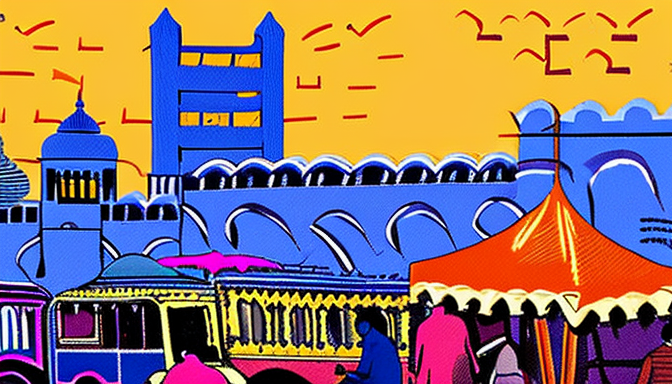Karachi is more than just a bustling metropolis; it’s a living tapestry woven with stories that echo through its streets. When you walk through the vibrant neighborhoods, you can almost hear the whispers of the past. Have you ever stopped to think about the lives that unfolded in these corners? Each alley, each old building holds a memory, a tale waiting to be told. Listening to the stories of those who witnessed Karachi’s evolution firsthand can be a mesmerizing experience.
Imagine sitting with an elderly resident, their eyes sparkling with memories. They might recount how this city transformed from a small fishing village into a sprawling urban center. Or they might share tales of the cultural exchanges that occurred at local markets, where spices and traditions mingled. These narratives are not just historical footnotes; they are the very essence of Karachi’s identity.
As you delve deeper, you’ll find that Karachi’s history is a rich melange of cultures. From the influences of the British Raj to the vibrant communities that have settled here, each group has left its mark. Listening to these stories is like piecing together a grand puzzle. Every piece reveals a new perspective, adding depth to our understanding of this city’s past.
So, next time you stroll through Karachi, take a moment. Listen closely. The stories of its people are alive, waiting to be discovered. They are the heartbeat of the city, reminding us that history is not just about dates and events—it’s about the lives that shaped them.
Forgotten Neighborhoods
In the heart of Karachi, there are that hold whispers of the past. These areas may not be in the spotlight, but they are rich with stories. Just imagine walking down a narrow street, where each corner has a tale to tell. Have you ever thought about what life was like in these hidden gems? Listening to the elders in these communities can be like opening a treasure chest of memories.
Take Lyari, for example. Once a vibrant hub, it has seen better days. But if you pause to chat with a local, they will share captivating stories of resilience. They’ll tell you about the bustling markets and the laughter of children playing in the streets. It’s a reminder that even in decline, there is beauty and strength.
Then there’s Korangi, a neighborhood often overlooked. Here, the tales of hardship and hope intertwine. Residents speak of their ancestors who built the community from scratch. It’s a place where history feels alive. The stories are not just about the past; they are about identity and pride.
So, what can we learn from these forgotten neighborhoods? They teach us to appreciate the rich tapestry of Karachi’s history. Each street, each building, holds a piece of the city’s soul. By listening to those who lived it, we can keep these stories alive. After all, isn’t it our duty to remember?

Cultural Mosaic
Karachi is not just a city; it’s a living tapestry woven from countless threads of culture, tradition, and history. As you stroll through the bustling streets, you can almost hear the whispers of the past. Each corner has a story to tell, a memory waiting to be uncovered. Have you ever stopped to listen to the tales of the elders? Their voices echo with experiences that shaped this vibrant metropolis.
From the aroma of street food to the colorful festivals, Karachi showcases a blend of influences that make it unique. The city is home to various ethnic groups, each contributing to its rich cultural landscape. Whether it’s the savory delights of Sindhi biryani or the sweet taste of Karachi’s famous gulab jamun, the food alone tells a story of migration and adaptation.
Consider this: Karachi is a melting pot of languages. Urdu, Sindhi, Punjabi, and English mingle in everyday conversations. This mix not only enriches communication but also reflects the city’s history as a crossroads of different cultures. To truly appreciate Karachi, one must embrace its diversity. Here’s a quick look at some of the major cultural influences:
| Culture | Influence |
|---|---|
| Indigenous | Rich traditions and local customs |
| Colonial | Architectural styles and governance |
| Modern | Globalization and contemporary art |
As you dive deeper into Karachi’s cultural mosaic, remember that every local has a story. So, next time you visit, take a moment. Listen to the stories of those who witnessed Karachi’s past first-hand. Their memories are not just tales; they are the legacy of a city that continues to evolve.
Frequently Asked Questions
- What makes Karachi’s history unique?
Karachi’s history is a vibrant tapestry woven from diverse cultural influences, ancient narratives, and modern developments. Each neighborhood has its own story, contributing to the city’s dynamic identity.
- Are there any hidden gems in Karachi worth exploring?
Absolutely! Many forgotten neighborhoods are brimming with history, unique architecture, and local traditions that tell the stories of communities long past. Exploring these areas can feel like stepping back in time.
- How does Karachi’s cultural diversity influence its cuisine?
The city’s rich cultural mosaic leads to a culinary scene that blends flavors and techniques from various traditions. From spicy street food to exquisite fine dining, Karachi’s food reflects its multicultural heritage.
- Can I find historical landmarks in Karachi?
Yes! Karachi is home to numerous historical landmarks, including colonial-era buildings, ancient mosques, and bustling markets that showcase the city’s evolution and heritage.
- What role do communities play in preserving Karachi’s history?
Local communities are the heartbeat of Karachi’s history. They actively engage in preserving their cultural narratives, ensuring that the stories of their ancestors continue to thrive and inspire future generations.